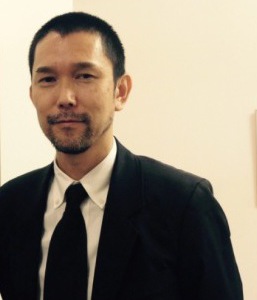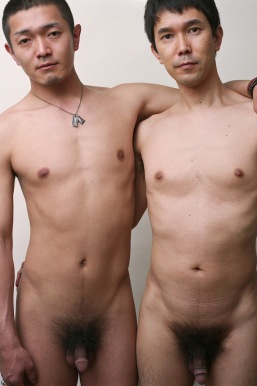With Me: An interview with Ryudai Takano

Japanese artist and photographer Ryudai Takano sat down one December afternoon in a Shinjuku gallery to discuss With Me, a series of photographs that gained a level of notoriety in 2014 when they became the subject of police intervention.
To begin with, Takano shared the chance story of how the series first came about. “The photos weren’t actually meant to be shown,” he explained. “It was just an archive, an exercise in capturing different skin tones. I am interested in showing diversity in my photography. Even among Japanese, our skin tones are different. These subtle differences were something I wanted to capture. After I’d begun shooting for a previous series in 2005, How to Contact a Man, which was also a nude series, I asked the models to stand so that the lens could compare their skin color to mine. [1] Because it was just an exercise, the series was totally unplanned, and there was no discussion or direction for my subjects.
“Of course, the subjects were a little surprised when I took off my clothes and stood right next them. All I said was, ‘Now I’m going to check your skin color.’ Anyway, these photos were just a bit of an experiment that got shelved away. But then, in 2009, when I was looking through my body of work, I reconsidered and decided to show them as artworks.”
“I guess, when I first took the photos, it was a little embarrassing because I’m naked. That’s probably why I didn’t consider them for display. But there was something quite interesting about them when I looked again, after four years in storage, that made me reconsider them as art.”
When asked about what kind of subjects he has included in the series, the artist became a little coy: “Well, there is a certain community represented in the series. These are my friends, or friends of friends. You can probably guess what kind of community.” When encouraged to be more specific, Takano remained vague. “Well, I don’t really wish to say. And I don’t know for sure. I don’t think it’s important.”
“What was really surprising about the photos, when I looked at them again, was that our faces are synchronized with each other. Without direction, or without even looking at each other, the expressions on my subjects’ faces and my face are somehow matching. It happened over and over again, with each new subject. Of course, it began as just trying to record skin colour, but there’s obviously more being captured here: the reaction, composition, face, and posture. All of it is recorded. It also captures what happens when two people – who are not family, nor lovers – stand close to each other, naked. And it seems to make some natural intimacy.”

Once exhibited in 2009, Takano continued With Me in Tokyo as well as Okinawa in southern Japan. As part of his residency at the Okinawa Prefectural Museum and Art Museum in 2009, Takano sought out locals, both men and women, to continue the series. “Unlike the earlier photographs, my subjects in Okinawa knew what to expect. Again, I didn’t give much instruction, but again, our expressions somehow match.”
In August 2014, the series was shown as part of a contemporary photography group exhibition at the Aichi Prefectural Museum of Art in Nagoya, central Japan. After an inspection from local police, the museum was requested to take down a handful of photographs from the series that featured full-frontal male nudity. The works were deemed “indecent.”
“We still don’t know if the display of these photos was illegal, even now. Police told the museum to take down the works, but it wasn’t clearly stated that it was illegal. What happened was that a couple of police officers or inspectors came to the museum and looked around. One of them said, ‘I don’t want to show this to my daughter.’ That is clearly a value judgment, not law. It’s a private judgment that was imposed upon the exhibition.”
When asked if he thought the censorship had anything to do with discrimination against gay people in Japan, these were Takano’s thoughts: “The police officer who made that remark about not wanting to show the work to his daughter, it could have been a homophobic reaction, yes. Perhaps there was even a double standard. Two naked men standing close to each other may have had a gay connotation for the police officer, but in history, sexuality was a lot more fluid in Japan. Same-sex relations, at least between men and boys, was just a part of the culture. There weren’t strict categories such as ‘straight’ and ‘gay.’ But now, this is not the case.”
Takano’s response was to cover the offending parts of the photographs, on top of the frames, with thin archive paper. “I followed orders from the authorities to cover them up, but it makes the spectacle more indecent, more illicit,” he explained. “In my opinion, their demand was indecent. Not the artwork.”
He also released a statement to a Japanese blog. Here is the last part of his statement:
From the very start, though, I cannot comprehend why “obscenity” is a crime. In our mature society, it is undeniable that a naked body possesses absolutely no destructive power…If we are going to talk about expressions that “harm society,” there are any number of more serious examples, yet the expressions that the government continually tries to expunge are entirely proper manifestations of human desire.
In any case, one thing is clear: the government is asserting its presence forcefully through the exercise of such power. If the government deviates from its stated purpose, i.e. to temporarily borrow authority from its citizens, and instead makes a display of this power, that act is far more grotesque than something like the display of genitalia. Once a violence that is not locatable to a specific person begins, it is difficult to stop. [2]
In the interview, Takano again asserted it was wrong for the display of his works to be treated as illegal. “I followed the police instructions because I didn’t want to dispute it in court. However, I’d still like people to address this issue in public, question the outcome, and start debate.”
“I’d also like to say that I appreciate the museum’s treatment of the exhibition in the face of more powerful authorities. It is unusual to find museums in Japan who will even attempt to include male nudity in their shows. Some people, in light of the police intervention, thought the museum was somehow weak, but what they don’t know is that this kind of incident hasn’t happened before because most museums tend to self-censor. They don’t even attempt to be bold. Museums should have more incidents like this in the future; it shouldn’t be about hitting the nail that sticks out.”
[1] The series How to Contact a Man succeeded another series, In My Room (2006)
[2] The translated statement can be found in full at Street Level Japan
Emily Wakeling
Emily Wakeling



